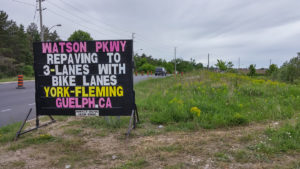Have you noticed roads in Guelph look different? We’ve compiled a list of frequently asked questions to explain how and why the City of Guelph chooses roads for redesign.
On this page
Why are my roads changing?
 As roads come up for reconstruction and repaving, the City considers the needs of all users (vehicles, pedestrians, bicycles and public transit)
As roads come up for reconstruction and repaving, the City considers the needs of all users (vehicles, pedestrians, bicycles and public transit)- Improvements are made when and where they are needed to balance the use of the right of way
- The City’s policies, including the Transportation Master Plan (2005), Council-approved Bicycle Policy (2009) and the Cycling Master Plan (2013) guide the future of Guelph’s transportation network
- Since 2009, all Guelph arterial road reconstruction includes the addition of bicycle lanes
- In some cases, considering the needs of all road users means the reduction of roadways from four- or three- lane roads to three- or two- lane roads
Do fewer lanes create traffic problems?
A typical lane in Guelph can handle 1,000 vehicles per hour. The City chooses to reduce the number of lanes when it is certain the level of service will be maintained. [Staff (1999). Geometric Design Guide for Canadian Roads. Transportation Association of Canada.]
What are the benefits?
Whether you are part of a young family or a visitor passing through the city, Guelph’s roads with a left turning lane and bicycle lanes offer safer streets for everyone.
On these roads:
- Research from across North America reveals the number of vehicles travelling over the speed limit is reduced by seven per cent when a roadway is reconfigured from a four- lane cross section to a three- lane cross section [Staff (2014). Safer Roads for a Safer Future. U.S. Department of Transportation. Retrieved from http://safety.fhwa.dot.gov/road_diets/info_guide/]
- In Guelph, ongoing monitoring of past road reconfigurations has found vehicle collisions are reduced by an average of seventeen per cent with no change in average vehicle volumes. [Staff (2015), The Corporation of the City of Guelph.]
- Left turn lanes with a curb, move left turning traffic out of the regular flow of traffic and reduce the likelihood of a rear-end collision or dangerous merging behaviour.
Why do we need bicycle lanes?
Adding bicycle lanes helps make Guelph a community that accommodates all road users, including public transit riders, cyclists, pedestrians and vehicle drivers. In a 2015 telephone survey Guelph residents informed us that improved infrastructure features motivate respondents to use a bicycle to travel to work, school or to run errands.
In fact, seventy per cent of respondents said they are more likely to ride a bicycle when there are bicycle lanes present. [Staff (2015). The Corporation of the City of Guelph. Telephone Survey.]
How does the City decide when a road needs to be redesigned?
The City considers all road users when redesigning roads, including drivers, bus riders, cyclists and pedestrians. The first step in the redesign process is an evaluation of relevant policy, including Council-approved Bicycle Policy (2009) and the Cycling Master Plan (2013). These two policies guide the development of the cycling network in Guelph, stipulating which roads should be developed as bicycle friendly routes.
Also during this process, the City considers both neighbourhood and wider community needs and impacts when planning our road networks. We collect information about:
- Current and forecasted traffic volumes
- Projected population growth
- Truck use
- Collision trends
- Parking requirements
- Transit impacts
During the final stage of the process the City selects the best option for the roadway based on the findings of the background research.
Who can I contact for more information?
Benita van Miltenburg
Project Manager Sustainable Transportation, Engineering and Transportation Services
519-822-1260 extension 2357
[email protected]
